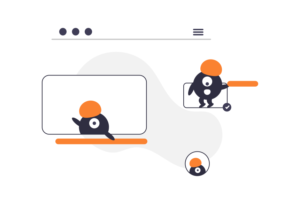
What Is A Landing Page on A Website?
A landing page on a website is a standalone web page with a single, focused objective, such as capturing leads or driving sales. Unlike a website’s homepage, which introduces a brand and its offerings, a landing page centres around a specific marketing campaign or advertising effort.
The primary aim of a landing page is converting visitors into leads or customers by guiding them through a targeted user journey. It eliminates distractions and unnecessary navigation elements, ensuring visitors quickly understand the value proposition and take the desired action, such as filling out a form or making a purchase.
Key Differences Between Landing Pages and Other Website Pages
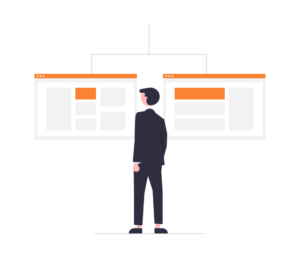
- Singular Focus: Homepages target multiple audiences and objectives, while landing pages have a singular goal, whether generating leads, selling a product, or promoting an event.
- Targeted Messaging: Landing pages feature tailored messaging and content for a specific audience segment, addressing their pain points and offering a relevant solution.
- Minimal Navigation: Unlike homepages, which provide numerous navigation options, landing pages typically have little to no navigation, keeping visitors focused on the primary call-to-action (CTA).
- Trackable Performance: Landing pages are designed for easy tracking and analysis, allowing marketers to measure their effectiveness and optimise for better conversion rates.
By directing potential customers or leads to a dedicated landing page on a website, businesses can streamline the user experience, deliver targeted messaging, and increase the likelihood of achieving desired outcomes, such as capturing valuable lead information or driving direct sales.
The Anatomy of an Effective Landing Page on a Website
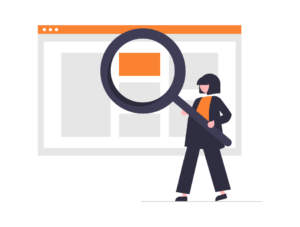
An effective landing page on a website is carefully crafted with several key elements. These work together to capture the visitor’s attention, convey the value proposition, and persuade them to take the desired action. Here are the essential components of a high-converting landing page:
Compelling Headline: The headline is the first thing visitors see and should immediately grab their attention while communicating the primary benefit or solution offered.
Persuasive Copy: The body copy should expand on the headline’s promise, providing more details about the offer, its features, and the benefits it delivers. Use benefit-driven language to address the visitor’s needs and desires, overcoming objections and driving action.
Engaging Visuals: Well-designed visuals, such as images or videos, can help reinforce the message and make the landing page more appealing and memorable. Visuals should be relevant, high-quality, and support the overall messaging and branding.
Prominent Call-to-Action (CTA): The call-to-action is the most critical element of a landing page, prompting the visitor to take the desired action, such as filling out a form, making a purchase, or signing up for a service.
Minimalistic Design: An effective landing page should have a clean and minimalistic design. Eliminate distractions and focus the visitor’s attention on the primary message and call-to-action. Remove unnecessary navigation menus, links, or other elements that could divert attention from the desired action.
Carefully crafting these key elements can effectively capture the visitor’s interest, communicate the value proposition, and guide them towards taking the desired action. This ultimately drives higher conversion rates and better marketing campaign performance.
Types of Landing Pages
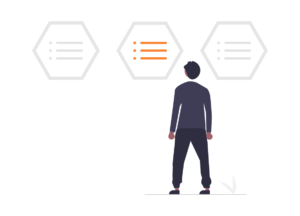
Landing pages can offer various types of content, products, or services to visitors, depending on specific marketing goals. Here are some common types of landing page offers:
Lead Generation
These landing pages aim to capture visitor information, such as email addresses or contact details, in exchange for a valuable offer like an ebook, white paper, webinar registration, or free trial. The primary objective is to generate leads for nurturing and eventual conversion into customers.
Click-Through
Click-through landing pages are designed to encourage visitors to take a specific action, such as clicking through to a product page, signing up for a service, or making a purchase. These pages often feature compelling copy, visuals, and a clear call-to-action (CTA) to guide visitors towards the desired next step.
Transactional
Transactional landing pages focus on facilitating direct sales or purchases. They typically feature product descriptions, pricing information, and a straightforward checkout process. E-commerce websites commonly use transactional landing pages to promote specific products or special offers.
Creating an effective landing page on a website involves understanding your audience’s needs and crafting a user-driven experience. By focusing on key elements such as compelling headlines, persuasive copy, engaging visuals, prominent CTAs, and minimalistic design, you can significantly improve your conversion rates. Ingenious App Studios is here to support you every step of the way in building the perfect landing page for your website.
Informational
Informational landing pages provide visitors with valuable content or resources. They are often related to specific topics or events. Examples include landing pages for event registrations, newsletter signups, or educational content downloads. The primary goal is to share information, establish thought leadership, or build an email list.
Understanding the different types of landing pages enables marketers to create targeted and effective pages. Landing pages should align with your specific campaign objectives, whether generating leads, driving sales, or sharing valuable information.
The Importance and Benefits
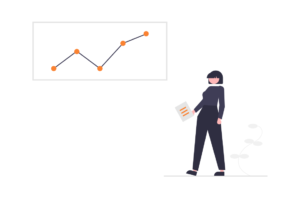
Landing pages significantly improve user experience and maximise marketing efforts. A well-designed landing page on a website has several benefits for businesses.
Increased Conversion Rates
Landing pages guide visitors towards a single desired action, enhancing conversion rates. By removing distractions and streamlining the user journey, pages ensure potential customers can take the next step easily. This focused approach outperforms traditional websites, where visitors might get sidetracked by multiple navigation options or competing calls-to-action.
Enhanced User Experience
Presenting relevant and targeted information tailored to visitors’ needs makes the experience more personalised and engaging. A targeted landing page on a website increases the likelihood of conversion and builds trust and credibility with potential customers.
Improved Advertising ROI
Directing paid traffic to dedicated landing pages allows businesses to track and attribute conversions more accurately. This data-driven approach ensures marketing budgets are spent effectively on the most profitable channels and initiatives.
Simplified Tracking and Analytics
Landing pages simplify performance tracking by isolating individual campaigns. Businesses gain valuable insights into what resonates with their audience, enabling informed decision-making and continuous improvement.
Targeted Messaging and Personalisation
Tailoring content, visuals, and messaging to specific audience segments creates highly relevant and compelling experiences. This enhances engagement, conversion rates, and fosters stronger brand loyalty and customer relationships.
Best Practices
To create a high-converting landing page on a website, follow these best practices:
Keep it Simple and Focused
Ensure the landing page has a single, clear objective. Avoid unnecessary elements that could distract from the desired action. Maintain a minimalistic design with a prominent call-to-action and clear value proposition.
Use Persuasive and Benefit-Driven Copy
Your landing page copy should highlight the benefits your offer provides. Address pain points, clearly communicate the value proposition, and use action-oriented language to encourage conversions.
Optimise for Mobile Devices
Ensure your landing page is optimised for mobile devices. Responsive design, easy navigation, and a streamlined experience are crucial for capturing mobile visitors.
Include Social Proof
Customer testimonials, reviews, or trust badges can significantly enhance your landing page’s credibility. Positive endorsements from satisfied customers or industry experts alleviate potential concerns and increase conversion likelihood.
Leverage Urgency and Scarcity
Creating a sense of urgency can motivate visitors to take action, using techniques like countdown timers and limited-time offers. However, use these tactics judiciously and avoid deception.
Landing Pages and Conversion Optimisation
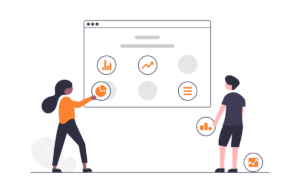
Landing pages are powerful tools for driving conversions. Their effectiveness can be maximised through continuous optimisation.
A/B Testing
A/B testing different variations of your landing page elements, such as headlines, copy, visuals, and calls-to-action (CTAs), helps identify what resonates best with your audience. This data-driven approach ensures your landing pages are optimised for maximum conversion rates.
Optimising Headlines and Copy
Your headline needs to be compelling and attention-grabbing. The copy should be persuasive and benefit-driven. Continuously refine your headlines and copy to improve conversion rates.
Visual Elements
High-quality visuals help convey your message, build trust, and increase engagement. A/B test different visuals to identify the most impactful ones for your audience.
Calls-to-Action (CTAs)
CTAs are essential for conversions. A/B testing different variations in button colours, text, and placement can optimise this critical element for maximum results.
Heat Maps and User Behaviour Data
Heat maps show where users click, scroll, and focus their attention. Combined with user behaviour data, you can identify friction points and areas for improvement.
Personalisation and Dynamic Content
Tailoring content and messaging to specific audience segments can create more relevant experiences. This leads to higher conversion rates and stronger customer relationships.
By following these best practices and using a data-driven approach, you can create a landing page on your website that drives more conversions and maximises your marketing investments.
The Role of Video on Landing Pages
Video has become an increasingly powerful tool for enhancing the effectiveness of landing pages. By incorporating video content, businesses can create a more engaging and visually appealing experience for their visitors, which can lead to higher conversion rates.
One of the key advantages of using video on landing pages is its ability to explain complex products or services in a clear and concise manner. With video, businesses can showcase their offerings in action, demonstrate features and benefits, and provide a more immersive experience for potential customers. This can be particularly valuable for products or services that require a deeper understanding or visual representation.
Additionally, video can help build trust and credibility with visitors. By featuring testimonials, customer success stories, or behind-the-scenes footage, businesses can establish a more personal connection with their audience and showcase the real-world impact of their offerings. This transparency and authenticity can go a long way in convincing visitors to take the desired action.
Numerous studies have shown that the inclusion of video on landing pages can significantly increase conversion rates. Videos can capture attention, convey information more effectively, and create a more memorable experience for visitors. When used strategically and in conjunction with other landing page elements, such as persuasive copy and clear calls-to-action, video can be a powerful tool for driving conversions.
Landing Page Examples and Case Studies
Airbnb’s Become a Host Landing Page
Airbnb’s host landing page is a prime example of effective landing page design. This page highlights the benefits of becoming an Airbnb host, showcasing the potential earnings, hosting tips, and success stories of current hosts.
The visuals are stunning, featuring high-quality images that capture the essence of hosting experiences. The copy is concise and compelling, immediately addressing potential hosts’ concerns and aspirations. The call-to-action is clear: “Get started,” encouraging visitors to take the first step toward becoming a host.
Key takeaways: Personalisation, visually appealing design, and a seamless user experience. Understanding what is a landing page on a website and how Airbnb employs these principles can inspire your own landing page strategies. By focusing on a clear value proposition and an inviting experience, you can engage and convert potential customers effectively.
Scouts Capital
Scoutscapital.com functions as a dynamic landing page aimed at connecting football talent worldwide. It combines the attributes of social media platforms with sports management tools.
The site utilises a clean and contemporary aesthetic with a focus on imagery related to football and talent exhibitions. The colour scheme and graphics enhance the sports-centric theme, making it appealing to the target audience.
The content is clear and targeted, with compelling headlines that highlight the site’s mission and benefits. The catchphrases like “From Local Heroes to Global Stars” and sections promoting digital adoption and player exposure are particularly effective. Strong call-to-action buttons such as “Join Waitlist” direct user engagement.
Throughout the site, there are multiple conversion-related elements, notably the “Join Waitlist” forms and CTAs that encourage users to sign up and get involved. Prominent sections such as “READY TO STAND OUT” further motivate users to take specific actions.
We can learn from Scouts Capital the efficacy of integrating clear and motivational content, user-centric navigation, and strategic conversion tools. These elements contribute to creating an engaging and action-driven landing page.
Actionable Tips for Implementation
- Identify a specific goal and design your landing page around that objective.
- Use compelling visuals, headlines, and copy that resonate with your target audience.
- Keep the design clean and free of distractions, with a clear and prominent call-to-action.
- Personalise the content and messaging based on the user’s journey and interests.
- Continuously test and optimise your landing pages through A/B testing and user feedback.
- Integrate your landing pages with your overall marketing campaigns for consistent branding and messaging.
Integrating Landing Pages with Marketing Campaigns

Integrating landing pages with your marketing campaigns is crucial for achieving maximum impact and return on investment (ROI). A well-designed landing page is not enough; it must align with your marketing efforts to deliver a cohesive experience for your audience.
One key aspect of successful integration is ensuring consistent messaging and branding across all touchpoints. Your landing page should reflect the same tone, visuals, and value proposition as your ads, email campaigns, social media posts, and other marketing materials. This consistency builds trust and credibility, reinforcing your brand identity and messaging.
Aligning your landing pages with advertising campaigns is particularly important when running paid ad campaigns. Whether you’re running Google Ads, social media ads, or display advertising, your landing page should directly correspond to the ad copy and offer. This creates a seamless transition, minimising confusion and increasing the likelihood of conversion.
Tracking and attribution are also essential components of integrating landing pages with your marketing campaigns. By implementing proper tracking mechanisms, you can measure the performance of your landing pages in relation to specific campaigns, channels, and sources. This data-driven approach allows you to optimise your efforts, allocate budgets effectively, and calculate the ROI of your marketing investments.
Utilise UTM parameters, campaign tracking codes, and analytics tools to accurately attribute conversions and leads to specific marketing channels and campaigns. This granular data will help you identify which campaigns and landing page combinations are performing best, enabling you to double down on successful strategies and refine underperforming ones.
Enhancing Email Campaigns
Integrating landing pages with your email marketing and lead nurturing campaigns can significantly boost engagement and conversion rates. By creating dedicated landing pages for email campaigns, you can provide a seamless experience for your subscribers, reinforcing the messaging and offers they’ve already expressed interest in.
Ultimately, understanding what is a landing page on a website and its integration with marketing campaigns requires a holistic and strategic approach. By aligning messaging, branding, and tracking efforts, you can create a cohesive and impactful user experience that maximises conversions and ROI across all your marketing initiatives.
Landing Page Creation and Optimisation Tools
Landing page builders and platforms like Unbounce, Instapage, and Leadpages provide user-friendly drag-and-drop interfaces and pre-designed templates. These tools make it easy for marketers to create professional-looking landing pages without needing extensive coding skills. They often integrate with popular marketing automation and CRM tools, simplifying the lead capture and follow-up process.
A/B testing and optimisation tools like Optimisely, VWO, and Google Optimise are essential for continuously improving landing page performance. These tools allow you to create and test different variations of your landing page elements, such as headlines, images, and calls-to-action. You can determine which versions resonate best with your audience and drive higher conversion rates.
Analytics and heat mapping solutions like Hotjar, Crazy Egg, and Lucky Orange provide valuable insights into user behaviour on your landing pages. Heat maps visually represent where users are clicking, scrolling, and focusing their attention. This helps you identify potential friction points or areas for improvement. These tools also offer session recordings, allowing you to watch real user interactions and uncover usability issues.
Personalisation and Dynamic Content Tools
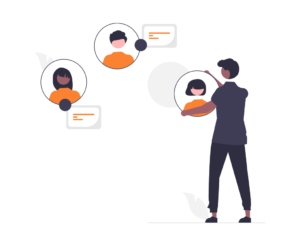
Personalisation and dynamic content engines like Evergage, Optimisely, and Adobe Target enable you to deliver tailored and relevant experiences to visitors based on their behaviour, demographics, or other data points. By dynamically adjusting the content, messaging, and offers on your landing pages, you can increase relevance and improve conversion rates for different audience segments.
Understanding what is a landing page on a website, along with using the various tools available for creation and optimisation, can simplify the journey from concept to market-ready product. At Ingenious App Studios, we are here to help you every step of the way, making your dreams a reality with a supportive and collaborative approach.
